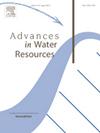Modeling and design of air injection-based hydraulic barriers
IF 4
2区 环境科学与生态学
Q1 WATER RESOURCES
引用次数: 0
Abstract
Hydraulic barriers are useful for manipulating groundwater flow to mitigate and contain harmful environmental effects. Injecting air into the aquifer has been suggested as a cost-efficient, sustainable, and reversible hydraulic barrier. In this, the injected air reduces the conductance of the aquifer to water flow. However, this practice is not commonly used despite its potential, probably due to a lack of a design tool and field-scale demonstrations. Evaluating the effect of air injection on the water flow is severely hindered by the ability to simulate the unstable coupled multiphase flow problem. Multiphase models are computationally expensive and unstable, require many (sometimes unattainable parameters), and generally provide poor predictive capabilities. Here, a simplified approach is suggested that decouples the phases flows, and uses analytical (fast, stable, parameters-parsimonious) solutions of the air injection problem to evaluate its effect on the water permeability field. In this manuscript, we describe the framework and the solutions of the air flow, discuss its limitations, and demonstrate its usability to evaluate the sensitivity to the media’s and system design parameters in three case studies: (i) point sources in a confined aquifer, (ii) line source in a confined aquifer, and (iii) line source in an unconfined aquifer.
基于空气喷射的液压屏障建模与设计
水力屏障有助于控制地下水流动,以减轻和遏制有害的环境影响。向含水层注入空气被认为是一种经济、可持续、可逆的水力屏障。在这种情况下,注入的空气降低了含水层对水流的导电性。然而,尽管这种做法很有潜力,但它并没有被普遍使用,这可能是由于缺乏设计工具和现场规模的演示。不稳定耦合多相流问题的模拟能力严重阻碍了对注入空气对水流影响的评估。多相模型在计算上昂贵且不稳定,需要许多(有时无法获得的参数),并且通常提供较差的预测能力。本文提出了一种相流解耦的简化方法,并利用注气问题的解析解(快速、稳定、参数简洁)来评价其对水渗透场的影响。在本文中,我们描述了气流的框架和解决方案,讨论了它的局限性,并在三个案例研究中证明了它在评估介质和系统设计参数敏感性方面的可用性:(i)承压含水层中的点源,(ii)承压含水层中的线源,(iii)无承压含水层中的线源。
本文章由计算机程序翻译,如有差异,请以英文原文为准。
求助全文
约1分钟内获得全文
求助全文
来源期刊

Advances in Water Resources
环境科学-水资源
CiteScore
9.40
自引率
6.40%
发文量
171
审稿时长
36 days
期刊介绍:
Advances in Water Resources provides a forum for the presentation of fundamental scientific advances in the understanding of water resources systems. The scope of Advances in Water Resources includes any combination of theoretical, computational, and experimental approaches used to advance fundamental understanding of surface or subsurface water resources systems or the interaction of these systems with the atmosphere, geosphere, biosphere, and human societies. Manuscripts involving case studies that do not attempt to reach broader conclusions, research on engineering design, applied hydraulics, or water quality and treatment, as well as applications of existing knowledge that do not advance fundamental understanding of hydrological processes, are not appropriate for Advances in Water Resources.
Examples of appropriate topical areas that will be considered include the following:
• Surface and subsurface hydrology
• Hydrometeorology
• Environmental fluid dynamics
• Ecohydrology and ecohydrodynamics
• Multiphase transport phenomena in porous media
• Fluid flow and species transport and reaction processes
 求助内容:
求助内容: 应助结果提醒方式:
应助结果提醒方式:


